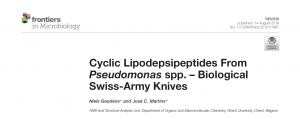N. Geudens & J.C. Martins, Frontiers in Microbiology, 2018
Pseudomonas spp. produce a large variety of CLiPs
Specific groups are defined with chemically similar Ps-CLPs and named for a particular prototype Ps-CLP . These include the viscosin, orfamide, amphisin, xantholysin, syringomycin, syringopeptin, and tolaasin groups. New CLPs are continuously found in numerous environments, and can be assigned to an existing group or constitute a new group, such as the recently discovered bananamides, and cocoyamides. Finally, a variety of Ps-CLP have not yet formally been classified as a group but can be treated as such, if the oligopeptide length is used as criterion. These include the entolysins, putisolvins, pseudofactins, syringopeptins, corpeptin, and fuscopeptins. With about 100 unique Ps-CLPs distributed over 15 groups characterized so far, the chance for rediscovery is obviously increasing, yet the expectation is that not all Ps-CLP groups have been uncovered so far.
Antimicrobial activities of Pseudomonas CLiPs
CLiPs represent a rich source of compounds in fundamental and application oriented research. The antifungal activity appears to be the most generally expressed property of CLiPs, followed by activity against Gram-positive bacteria. The lack of activity originally suggested for CLiPs in the case of Gram-negative bacteria should nuanced. Although clearly less successful than against Gram-positive bacteria, the different cell envelope architecture of Gram-negative bacteria does not provide absolute protection from CLiPs. A notable difference with Gram-positive bacteria is the larger selectivity. For example, the xantholysins show potent effects against Pseudomonas and Xanthomonas species, but have no effect against Escherichia. Other CLiPs also possess interesting effects against Gram-negative bacteria.
Time for a concerted action?
Unfortunately, in depth analysis learns that no overlap exists between the collection of Gram-negative bacteria used to test the activity of the various CLiP groups. Therefore, generalizations regarding the biological activities of Ps-CLPs should be avoided or presented with the appropriate context. In spite of the increasingly large body of activity data, the large diversity in the handful of organisms selected for activity assays from one study to another, let alone the diversity in procedures used and concentration ranges tested, limits meaningful comparison of the potency of Ps-CLPs or derivation of structure-activity relationships to a few very specific cases. In our opinion, this causes considerable hindrance for the further exploration and development of Ps-CLPs as biological agents


